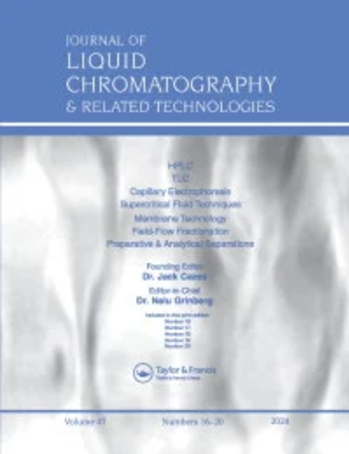UHPLC-APCI-TQ-MS analytical method to quantify nitrosamine impurities in the commercial formulation of metformin and glipizide
IF 1.2
4区 化学
Q4 BIOCHEMICAL RESEARCH METHODS
Journal of Liquid Chromatography & Related Technologies
Pub Date : 2022-05-09
DOI:10.1080/10826076.2022.2126856
引用次数: 1
Abstract
Abstract As per the ICH M7 guideline nitrosamine impurities are referred to as cohort of concern which are having a potential significant carcinogenic risk and for the safe human consumption of drug products, the levels of nitrosamine impurities need to be controlled as per respective permissible daily exposures (PDE). An accurate, precise, sensitive, and robust UPLC-APCI-TQ-MS/MS method has been developed for the quantification of eight nitrosamine impurities in the marketed formulation of metformin and glipizide Tablets. Chromatographic separation was achieved using Kinetex® 150 × 3.0 mm Biphenyl 100 Å, 2.6 µm column with mobile phase A (0.1% w/v formic acid dissolved in water) and mobile phase B (0.1% w/v formic acid dissolved in methanol) with a flow rate of 0.4 mL per minute having run time of 20 min with gradient mode of elution. As per ICH Q2(R1) guideline the method had been validated which demonstrates the sensitivity of the developed method with a good linearity range of 1–5 ng/mL for all eight nitrosamine impurities. The validation parameters suggest that the developed method for the simultaneous quantification of eight nitrosamine impurities in the marketed formulation of metformin hydrochloride and glipizide can be routinely applied in the quality control laboratory. Graphical AbstractUHPLC-APCI-TQ-MS分析方法定量二甲双胍和格列吡嗪市售制剂中亚硝胺类杂质
摘要根据ICH M7指南,亚硝胺杂质被称为具有潜在重大致癌风险的关注人群,为了人类安全食用药品,需要根据各自的允许每日暴露量(PDE)控制亚硝胺的杂质水平。已开发出一种准确、准确、灵敏且稳健的UPLC-APCI-TQ-MS/MS方法,用于定量二甲双胍和格列吡嗪片市场配方中的八种亚硝胺杂质。使用Kinetex®150实现色谱分离 × 3 mm联苯100 Å,2.6 µm柱,流动相A(0.1%w/v甲酸溶于水)和流动相B(0.1%w/w甲酸溶于甲醇),流速为0.4 毫升/分钟,运行时间为20 min,采用梯度洗脱模式。根据ICH Q2(R1)指南,该方法已得到验证,证明了所开发方法的灵敏度,线性范围为1-5 所有八种亚硝胺杂质的浓度均为ng/mL。验证参数表明,所开发的同时定量盐酸二甲双胍和格列吡嗪市售制剂中八种亚硝胺杂质的方法可以在质量控制实验室中常规应用。图形摘要
本文章由计算机程序翻译,如有差异,请以英文原文为准。
求助全文
约1分钟内获得全文
求助全文
来源期刊
CiteScore
2.80
自引率
0.00%
发文量
29
审稿时长
4.9 months
期刊介绍:
The Journal of Liquid Chromatography & Related Technologies is an internationally acclaimed forum for fast publication of critical, peer reviewed manuscripts dealing with analytical, preparative and process scale liquid chromatography and all of its related technologies, including TLC, capillary electrophoresis, capillary electrochromatography, supercritical fluid chromatography and extraction, field-flow technologies, affinity, and much more. New separation methodologies are added when they are developed. Papers dealing with research and development results, as well as critical reviews of important technologies, are published in the Journal.

 求助内容:
求助内容: 应助结果提醒方式:
应助结果提醒方式:


